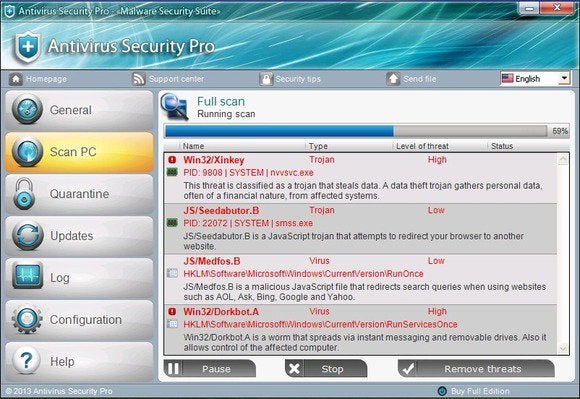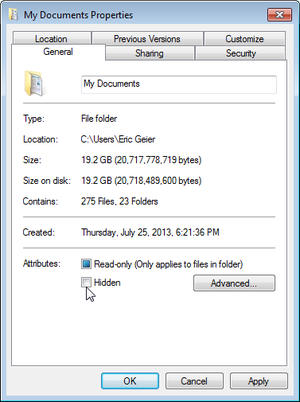With the nasty CryptoLocker malware making the rounds—encrypting its victims’ files, and then refusing to provide the unlock key unless a payment of $300 is made via Bitcoin or a prepaid cash voucher—ransomware is back in the spotlight.
You can remove many ransomware viruses without losing your files, but with some variants that isn’t the case. In the past I’ve discussed general steps for removing malware and viruses, but you need to apply some specific tips and tricks for ransomware. The process varies and depends on the type of invader. Some procedures involve a simple virus scan, while others require offline scans and advanced recovery of your files. I categorize ransomware into three varieties: scareware, lock-screen viruses, and the really nasty stuff.
Scareware
The simplest type of ransomware, aka scareware, consists of bogus antivirus or clean-up tools that claim they’ve detected umpteen issues, and demand that you pay in order to fix them. Some specimens of this variety of ransomware may allow you to use your PC but bombard you with alerts and pop-ups, while others might prevent you from running any programs at all. Typically these invaders are the easiest type of ransomware to remove.
Lock-screen viruses
Next is the ransomware variety I call lock-screen viruses, which don’t allow you to use your PC in any way. They display a full-size window after Windows starts up—usually with an FBI or Department of Justice logo—saying that you violated the law and that you must pay a fine.
The really nasty stuff
Encrypting malware—such as CryptoLocker—is the worst variant, because it encrypts and locks your personal files until you pay up. But even if you haven’t backed up your files, you may have a chance to recover your data.
Removing ransomware
Before you can free your hostage PC, you have to eliminate the hostage taker.
If you have the simplest kind of ransomware, such as a fake antivirus program or a bogus clean-up tool, you can usually remove it by following the steps in my previous malware removal guide. This procedure includes entering Windows’ Safe Mode and running an on-demand virus scanner such as Malwarebytes.
If the ransomware prevents you from entering Windows or running programs, as lock-screen viruses typically do, you can try to use System Restore to roll Windows back in time. Doing so doesn’t affect your personal files, but it does return system files and programs to the state they were in at a certain time. The System Restore feature must be enabled beforehand; Windows enables it by default.
To try System Restore, shut down your PC and locate the F8 key on your PC’s keyboard. Turn the PC on, and as soon as you see anything on the screen, press the F8 key repeatedly. This action should bring up the Advanced Boot Options menu; there, select Repair Your Computer and press Enter. Next you’ll likely have to log on as a user; select your Windows account name. (If you don’t have a password set, leave that blank.) Once logged on, you’ll find shortcuts to a few tools; click System Restore.
If you don’t see the Repair Your Computer option on the Advanced Boot Options menu, you can use your Windows disc (if you have that) to access the recovery tools. Click Repair your computer on the main menu before proceeding with the installation. Alternatively, you can create a Windows System Repair Disc on another PC running the same Windows version, and then boot to that disc on the infected PC to reach the same recovery tools.
If System Restore doesn’t help and you still can’t get into Windows to remove the ransomware, try running a virus scanner from a bootable disc or USB drive; some people refer to this approach as an offline virus scan. My favorite bootable scanner is from Bitdefender, but more are available: Avast, AVG, Avira, Kaspersky, Norton, and Sophos all offer antivirus boot-disk software, as we mentioned in PCWorld’s recent roundup of the best boot-drive programs.
If you still have no luck after trying Safe Mode and an on-demand scanner, performing a System Restore, and running an offline virus scanner, your last resort is likely to perform a factory restore. Most ransomware isn’t that tenacious, however.
Recovering hidden and encrypted files
With that out of the way, it’s time to repair the damage. If you’re lucky, your PC was infected by malware that didn’t encrypt your data, but merely hid your icons, shortcuts, and files.
You can easily show hidden files: Open Computer, press the Alt key, select Tools, and click Folder Options. On the View tab, select Show hidden files, folders, and drives, and then click OK.
If your data reappears after you elect to show hidden files, that’s great—it means there’s an easy fix for your woes. Open Computer, navigate to C:\Users\, and open the folder of your Windows account name. Then right-click each folder that’s hidden, open Properties, uncheck the Hidden attribute, and click OK. Boom! Done.
If you still can’t find your data, and your files really have been malware-encrypted, you’re in trouble: Usually it isn’t possible to just decrypt or unlock your hostage files, because the decryption key is typically stored on the cybercriminal’s server. Some victimized users have reported that some pieces of malware will keep their promise, decrypting and returning your files once you pay (in particular, CryptoLocker’s handlers have been diligent about releasing the files of infected users who pay the ransom demand), but I don’t recommend paying.
This is why we constantly tell you to back up your PC on a regular basis.
If you previously set and created backups, scan them for viruses on another PC (one that is not infected) if at all possible. If all of your important files are backed up, you can proceed in removing the malware and then simply restoring your backed-up files.
If you don’t have a backup system in place, you might be able to recover some files from Shadow Volume Copies—if the malware hasn’t deleted them. Shadow Volume Copies is part of Windows’ System Restore feature. Either right-click Select files/folders and open Properties to view the Previous Versions list, or use a program called Shadow Explorer to browse the snapshots.
But don’t rely on that. Start backing up your PC today, and do it regularly.
Preventing ransomware and malware infections
Avoiding ransomware is much the same as avoiding other types of other malware.
Always run a good antivirus utility and keep Windows and browser-related components (Java, Adobe, and the like) updated. Keep your browser clean to prevent adware invasions that could lead to malware infections. Always, always be wary of unexpected email attachments and spam. (CryptoLocker spreads via .zip files sent as email attachments, for example.)
And just to beat this dead horse one more time: Always have a good backup system in place, just in case your PC does become infected and you can’t recover your files. Yes, it’s that important.







If you are facing any issue while working with malwarebytes anti malware then you can visit the page to get the information about why malwarebytes not opening, or how to reinstall malwarebytes premium
ReplyDelete